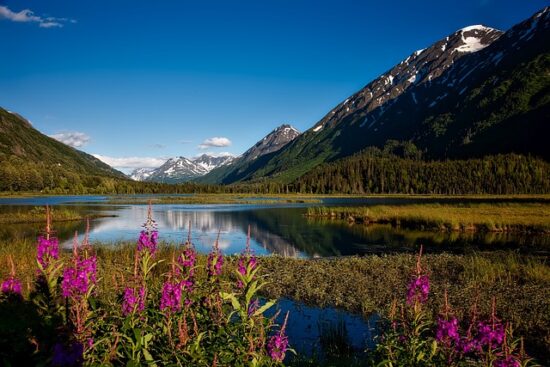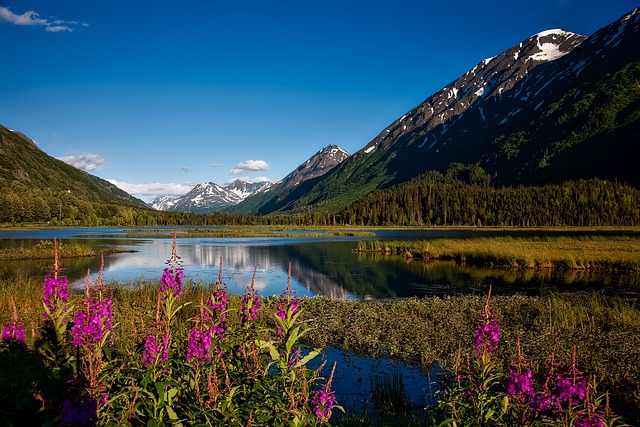Alaska is the largest state of United States by Area. It ranks as the 4th least populated state of the country. Alaska shares its borders with Arctic Ocean to the north, British Columbia to the east, and Russia to the south-west. About half of the Alaskans live in the Anchorage metropolitan area. The state is rich in natural resources including oil and natural gas. These two resources run Alaska’s economy.
Alaska Facts For Kids
Introduction
- Official Language: English
- Capital City: Juneau
- Ranking: Largest U.S. State
- Nickname: The Last Frontier
- Motto: North to the Future
History
- Previously Russia occupied Alaska but on March 30, 1867, the U.S. purchased the state for 7.2 million dollars.
- On May 11, 1912, Alaska was organized as a territory.
- On January 3, 1959, Alaska had become the 49th U.S. State.
- Many indigenous people used to live in Alaska before the Europeans finally arrive.
- According to the Nikolai Daurkin’s statement (Nikolai was a geographer who traveled Alaska in 18th century); the Russian settlement in the state was as early as 17th century.
- On July 7, 1958 Congress approved the statehood of Alaska.
- On March 27 1964, Great Alaskan Earthquake struck on Good Friday killing 133 people. The earthquake lasted for about 4 minutes and 38 seconds. It has a magnitude of 9.2.
Geography & Size
- Alaska has the total population of 735,132 as of 2013.
- Juneau is the capital city of Alaska. It is also the second largest city of United States by area.
- Anchorage is the largest city of Alaska with 298,610 numbers of residents.
- The total area of Alaska is 663,268 sq. miles. It is twice the size of Texas.
- Mount McKinley is the highest point of the state with the elevation measuring at 20,320 feet. It is also the highest peak all throughout the North America.
- Ocean is the lowest point of the state.
- South Central Alaska is the most populous region of the state.
- The largest region of Alaska is the interior part most of which is wilderness. The Denali National Park and Preserve is also located in the interior region.
- The southwest region of Alaska is 500 miles long. Kodiak Island is also located in the southwest area.
- Alaska has Aleutian Islands that are 1,200 miles long and they consist of 300 small volcanic islands.
- Mount Shishaldin is the most perfect volcano and it rises up to 10,000 feet.
- There are 3 million lakes and 100,000 glaciers in Alaska.
- The U.S. government own and manage 65% of Alaska.
- The largest wildlife refuge in the world is the Arctic National Wildlife Refuge. It covers an area of 16 million acres.
 Climate
Climate
- The warmest region of Alaska is the southeast which is also the wettest part of the state. It receives little rain throughout all year round. Juneau receives 50 inch rainfall on average while Ketchikan rainfall averages 150 inches.
- The south central part has a mild climate as compared to the other Alaskan parts because it is close to the seacoast. Although the south central part receives little rain yet the region experiences heavy snow. Anchorage generally receives 75 inch snow.
- The Bering Sea and the Gulf of Mexico largely determines the western Alaska’s climate.
- The Kobuk River valley is a desert which is why it receives no more than 10 inches of rainfall each year.
- Dillingham and Bethel has got the extreme climates in that they receive 100 inches of rainfall annually.
- Fort Yukon has the record lowest high temperature (of 100o F) in the U.S. it was recorded on June 27, 1915.
- Prospect Creek has got the lowest ever temperature of -80o F and it was recorded on January 23, 1971.
- Thompson Pass, near Valdez, had received the heaviest rainfall of 974.5 inches in the winter of 1952-53.
People and Economy
- About 84% of Alaskans speak English while only 3.5% speak Spanish at home.
- The state generates more than 80% of its incomes from oil and gas resources.
- The area for each person in Alaska is about 0.9 square mile per person while in New York it is 0.003 square mile per person.
- The traditional farming of Alaska is grouped into Matanuska Valley and Tanana Valley.
- About 15 – 18 million acres in Alaska are arable but only 1% of the land (900,000) is used for farming.
- The market value of total agricultural products of Alaska was $53 million.
- In the Union, the Alaska is the most flying state. The only way to reach rural areas of Alaska is by airplane.
Fauna and Flora
- Alaska is home to 222 species of wildlife including migratory and resident species. All these species are found in Alaska Peninsula Refuge.
- The state has 30 terrestrial mammals including 11 marine mammals.
- There are 35 fish species and 146 bird species.
- While some of the species occur on the islands off the Pacific Coast a few others are found on the Bristol Bay lowlands.
- Fish includes salmon, trout, pike, grayling, and burbot. Each year, almost 2 million fish are caught commercially.
- Almost 400,000 geese live in the Bering Sea.
- About 2,000 – 3,000 grizzly bears are found in the peninsula.
Did You Know…? Alaska Facts For Kids
- Alaska is the second-largest producer of oil in the United States. It produces 400,000 barrels of oil every day.
- A small portion of economy relies on Agriculture including dairy products, vegetables, nursery stocks, and livestock.
- The median age of Alaskans is 33.4.
- The state has the 16th largest per capita personal income averaging $35,612 in 2005.
- Anchorage Daily is the largest newspaper with the circulation of 89,423 on Sundays.
- Klondike Gold Rush National Historical Park is the most popular national park in Alaska. It is located in Skagway. It was visited by 888,255 people in 2005.
- The farthest-north city of Alaska is Barrow which is 350 miles north of the Arctic Circle.
- Anchorage’s Lake Hood is the world’s busiest seaplane base. It handles as much as 600 flights in peak summer day.
- Anton Anderson Memorial Tunnel is the longest highway of North America. It is located on the Portage Glacier Highway and it runs 2.5 miles.
- Wood-Tikchik State Park is the Alaska’s largest contiguous park. It covers 1.6 million acres of wilderness.
- About 5% of Alaska is covered with glaciers. These glaciers are 29,000 square miles.


Leave a Reply